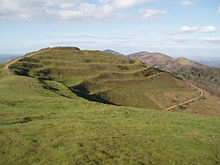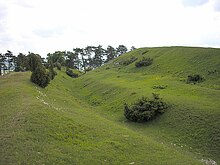
In fortification architecture, a rampart is a length of embankment or wall forming part of the defensive boundary of a castle, hillfort, settlement or other fortified site. It is usually broad-topped and made of excavated earth and/or masonry.[1][2]

In fortification architecture, a rampart is a length of embankment or wall forming part of the defensive boundary of a castle, hillfort, settlement or other fortified site. It is usually broad-topped and made of excavated earth and/or masonry.[1][2]


The composition and design of ramparts varied from the simple mounds of earth and stone, known as dump ramparts, to more complex earth and timber defences (box ramparts and timberlaced ramparts), as well as ramparts with stone revetments.[2] One particular type, common in Central Europe, used earth, stone and timber posts to form a Pfostenschlitzmauer or "post-slot wall". Vitrified ramparts were composed of stone that was subsequently fired, possibly to increase its strength.[2]
Many types of early fortification, from prehistory through to the Early Middle Ages, employed earth ramparts usually in combination with external ditches to defend the outer perimeter of a fortified site or settlement.[2] Hillforts, ringforts or "raths" and ringworks all made use of ditch and rampart defences, and they are the characteristic feature of circular ramparts. The ramparts could be reinforced and raised in height by the use of palisades. This type of arrangement was a feature of the motte and bailey castle of northern Europe in the early medieval period.
During the classical era, societies became sophisticated enough to create tall ramparts of stone or brick, provided with a platform or wall walk for the defenders to hurl missiles from and a parapet to protect them from the missiles thrown by attackers. Well known examples of classical stone ramparts include Hadrian's Wall and the Walls of Constantinople.

After the fall of the Western Roman Empire, there was a return to the widespread use of earthwork ramparts which lasted well into the 11th century, an example is the Norman motte and bailey castle. As castle technology evolved during the Middle Ages and Early Modern times, ramparts continued to form part of the defences, but now they tended to consist of thick walls with crenellated parapets.[3] Fieldworks, however, continued to make use of earth ramparts due to their relatively temporary nature.
Elements of a rampart in a stone castle or town wall from the 11th to 15th centuries included:

In response to the introduction of artillery, castle ramparts began to be built with much thicker walling and a lower profile, one of earliest examples first being Ravenscraig Castle in Scotland which was built in 1460.[5] In the first half of the 16th century, the solid masonry walls began to be replaced by earthen banks, sometimes faced with stone, which were better able to withstand the impact of shot; the earth being obtained from the ditch which was dug in front of the rampart. At the same time, the plan or "trace" of these ramparts began to be formed into angular projections called bastions which allowed the guns mounted on them to create zones of interlocking fire.[6] This bastion system became known as the trace italienne because Italian engineers had been at the forefront of its development, although it was later perfected in northern Europe by engineers such as Coehoorn and Vauban and was the dominant style of fortification until the mid-19th century.
Elements of a rampart in an artillery fortification from the 16th to 19th centuries included:
As well as the immediate archaeological significance of such ramparts in indicating the development of military tactics and technology, these sites often enclose areas of historical significance that point to the local conditions at the time the fortress was built.[2]